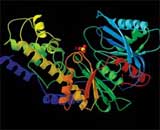
LNLS/CBMEThree-dimensional structure of a yeast proteinLNLS/CBME
FAPESP has approved funding for 16 research groups that will form the Network of Structural Molecular Biology – SMOLBnet -, for the study of the three-dimensional structures and functions of about 200 proteins. Each one of the groups will receive US$ 78,000 in the course of four years’ work, to analyze between four and eight proteins. In the case of some laboratories, this amount may reach the figure of US$ 105,000, if funds for the purchase of equipment are added on. The expectation is that this research will provide clues for the development of medicaments to fight various kinds of disease.
The chosen groups will be analyzing the genes mapped in the Human Cancer Genome and Sugarcane Genome projects, and in the genomes of the Xylella fastidiosa and Xanthomonas citrii bacteria. Also being proposed are studies of the structure of proteins connected with other public health problems that were already being studied by several laboratories.
SMOLBnet should enhance Brazil’s competence in the field of structural molecular biology, contributing towards the qualification of researchers and increasing the quality of proteins studied. Brazil currently accounts for about 0.25% of the world production of proteins analyzed.
Proteins are organic compounds with very versatile structures. They are responsible for almost all the biological processes in an organism, and they take part in organic processes of great complexity. Knowledge of their structure and functions in normal cells will make it possible to compare how they manifest themselves in sick cells. This information will make it possible for important clues to be provided, for scientists to decode the process of disease and to arrive at more efficient diagnoses and new treatments. From the analysis of the structure of the protein associated with HIV, for example, it was possible to develop inhibitors of protease, which are present in the cocktail of medicines that have been used since 1996 by carriers of Aids.
Support of the CBME
The majority of laboratories that will make up the network is now carrying out cloning of genes up to their expression in protein. Some are equipped to reach the stage of purification, and only three groups have experience in crystallization. They will all be able to use the infrastructure of the Center of Structural Molecular Biology (CBME), set up in the National Laboratory of Synchrotron Light, in Campinas. “We can support them in all the stages of the research, from the cloning of the gene, its expression in protein, the purification and crystallization of the proteins, to determining its structure by X-ray diffraction”, says Rogério Meneghini, a director of the CBME.
The center also has two apparatuses at its disposal, purchased with funds from FAPESP, that make it possible to analyze the structure of a protein by nuclear magnetic resonance. It is with the help of equipment like this that the CBME is analyzing the structure of a score of proteins, some of which have the potential for fighting various kinds of disease, such as hepatitis B, malaria and cancer.The expectation is that before the decade is over it will be possible to arrive at the first group of products of the structural genome, such as, for example, perfecting ways of diagnosing tumors and developing treatments and inhibitors of protein molecules, active in serious diseases.
Chosen laboratories
Center of Molecular Biology and Genetic Engineering – Unicamp
Dept. of Applied Physics of the Institute of Physics of São Carlos – USP
Dept. of Histology and Embryology of the Institute of Biomedical Sciences – USP
Dept. of Biochemistry of the Institute of Chemistry – USP
Dept. of Gynecology – Unifesp
Dept. of Microbiology of the ICB – USP
Dept. of Biology of the Institute of Biosciences – USP
Dept. of Biophysics of Unifesp and the University of Mogi das Cruzes (UMC)
Dept. of Cellular and Molecular Biology and Pathogenic Bioagents of FMRP – USP
Institute of Chemistry of Unesp in Araraquara
Dept. of Microbiology, Immunology and Parasitology – Unifesp
Dept. of Biochemistry of the Institute of Chemistry – USP
Dept. of Microbiology and Immunology of the Institute of Biology – Unicamp
Dept. of Physics – Unesp
Dept. of Biochemistry of the Institute of Chemistry – USP

